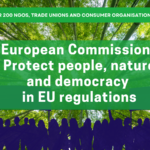Brussels 1st of March 2023
Dear Minister,
You have been invited to discuss the European Commission’s proposal to establish an EU certification framework for carbon removals (the CRCF) at the March Environment Council meeting. The members of Climate Action Network Europe have identified a number of critical shortcomings in the proposal. In this letter we outline our main concerns and propose solutions to allow the EU’s future carbon removal activities to be beneficial for climate.
Removals must not distract from the efforts to reduce emissions – offsetting must be excluded. While Climate Action Network Europe supports the development of a sustainable and environmentally effective legislative framework for carbon dioxide removal (CDR) in the EU, we stress that dangerous climate change can only be prevented by rapid and deep emission reductions. Carbon removals will only be able to play a limited role in climate mitigation efforts and they need to be additional to emission reductions, not done instead of them. In its current form, the CRCF allows offsetting of emissions with removals. This will delay decarbonisation and could
result in European citizens being misled with greenwashing. The best way to ensure that CDR does not hamper decarbonisation is maintaining and strengthening the firewall between emissions and removals. It is important that any form of offsetting or compensating of emissions through EU certified removal units be explicitly excluded under the CRCF’s operational articles.
Emissions reductions and temporarily parked emissions are not carbon removals. The CRCF proposal allows for certification of temporary removals in products, vegetation and soils. These categories are highly problematic, they are vulnerable to reversals as well as to inaccurate accounting and their monitoring is expensive, laborious and unreliable. The Commission proposal also allows for certifying emission reductions from biogenic pools such as peatland as removals. Such emission reductions are extremely important, but they are not removals and therefore must not be certified as such in the CRCF. To qualify as carbon removal, CO2 must be removed from the atmosphere and stored in a manner intended to be permanent. Activities that are important but do not fit within the definition of carbon removal should be incentivised with different policy tools.
Land-based activities need to support ecosystem restoration and biodiversity protection. The climate and biodiversity crises are intimately linked and must be tackled together. Biodiversity protection and enhancing nature’s resilience are also the best route for long term nature based carbon storage and sequestration. The CRCF proposal does not adequately take into account the multitude of other functions that nature provides beyond carbon sequestration, such as biodiversity and ecosystem health. In addition, due to the short length of the biogenic carbon cycle, risk of reversals, inaccurate accounting, and difficulties for ensuring additionality we believe
that nature based carbon removals are better suited to be supported by activity based finance with clear environmental and climate benchmarks rather than carbon credits.
Lastly, we would like to point out the crucial importance of an inclusive and democratic process when certifying removals, and we do not support the current Commission’s proposal to grant itself such a broad exercise of power through the planned delegated acts. Each different carbon removal method comes with its trade-offs, side-effects and co-benefits and requires an appropriate societal debate and scrutiny, which the proposal now excludes. We hope that you will consider these key concerns. We would also be keen to have an opportunity to discuss this proposal with you at the earliest occasion.
Yours sincerely,
Chiara Martinelli
Director of CAN Europe



